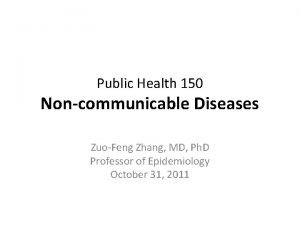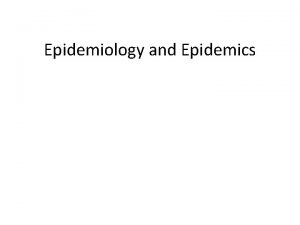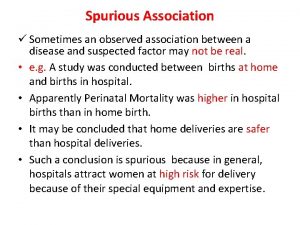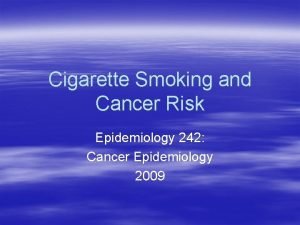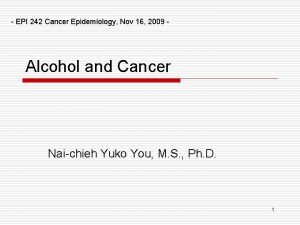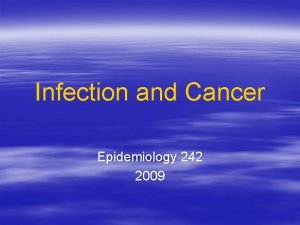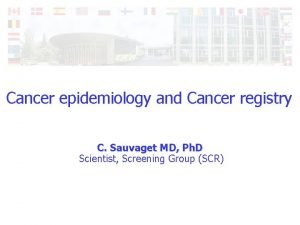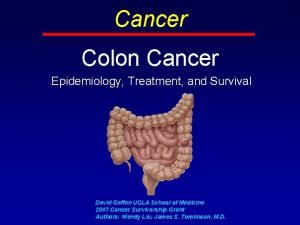Epidemiology 242 Cancer Epidemiology ZuoFeng Zhang MD Ph
































- Slides: 32

Epidemiology 242: Cancer Epidemiology Zuo-Feng Zhang, MD, Ph. D Fall Quarter, 2009

Overall Objectives of the Course • The overall objectives are to introduce basic concept in cancer epidemiology, including concepts of carcinogenesis, multistage models, pre-malignant lesion, international patterns of cancer.

Overall Objectives of the Course • To discuss major etiologic issues for a variety of cancers including smoking, alcohol drinking, virus, radiation, nutrition, occupational and environmental exposures. • To review epidemiological data on major cancers including prostate, breast, lung, and other cancers. • To lecture on the basic concepts of molecular and genetic epidemiology.

Introduction to Cancer Epidemiology • (1) To overview the cancer magnitude • (2) To familiarize students with basic concepts of tumor and its classification • (3) To introduce basic concept of carcinogenesis and cancer epidemiology

Why Cancer is a Major Public Health Problem? • Improved medical care and public health have lead to: • Decrease and control of common diseases of childhood and infectious disease, the major causes of death in the past • the increase of life expectation • the increase of the proportion of aging population, since cancer is generally considered as an aging disease, cancer becomes a major public health problem.


Number of deaths for leading causes of death • • • Heart disease: 631, 636 Cancer: 559, 888 Stroke (cerebrovascular diseases): 137, 119 Chronic lower respiratory diseases: 124, 583 Accidents (unintentional injuries): 121, 599 Diabetes: 72, 449 Alzheimer's disease: 72, 432 Influenza and Pneumonia: 56, 326 Nephritis, nephrotic syndrome, and nephrosis: 45, 344 Septicemia: 34, 234






Incidence by sex and cancer site, World 2002 Source: Table 1: Parkin DM, et al. CA Cancer J Clin [2005]; 55: 74 -108

Mortality by sex and cancer site, World Source: Table 1: Parkin DM, et al. CA Cancer J Clin [2005]; 55: 74 -108

The Major Cancers • Lung (ICD-10 C 33 and C 34) • Breast (female, C 50) • Colon/rectum (C 18 -C 20) • Stomach (C 16) • Prostate (C 61) • Liver (C 22) • Cervix uteri (C 53) • Esophagus (C 15)

What is Cancer Epidemiology?

Definition • Cancer epidemiology is the study of the pattern of cancer in populations. • Its essential aim is to identify causes of cancer, including preventable (avoidable) causes and inherited tumor susceptibility. • It is also play an critical role in many other areas of cancer research including evaluation of screening effects, cancer prevention and control • Current studies directions includes molecular and genetic epidemiology of cancer.

Types of Epidemiologic Studies • Descriptive Epidemiologic study: To describe the difference in occurrence of a particular cancer between different groups (age, gender, race, country, a period of time for time trend) and to generate the hypothesis for increased/decreased for the specific tumor type.

Types of Epidemiological Studies • Analytic Epidemiology: To study risk factors or potential causes of cancer by a particular study design, e. g. , case-control study or cohort study.

Types of Epidemiological Studies • Intervention studies: Applying the knowledge (risk/protective factors) obtained from analytic epidemiological studies to specific population in order to reduce the risk of cancer.

Risk factors for Cancer

Percentage of Cancer Deaths Attributed to Various Factors (Doll R and Peto R, JNCI, 1981) • • • Tobacco Use: 30% (25%-40%) Diet: 35% (10%-70%) Infection: 10%? (1%-? ) Reproductive & Sexual Behavior: 7% (1%-13%) Occupation: 4% (<2%-8%) Alcohol: 3% (2%-4%) Geophysical factors (natural radiation): 3% (2 -4%) Pollution: 2% (<1% – 5%) Food additive: <1% (-5% – 2%) Medicines and Medical Procedures: 1% (0. 5%-3%) Industrial consumer products <1% (<1%-2%) Unknown: ? , ?

Harvard Center for Cancer Prevention (www. hsph. harvard. edu/cancer) • • • Tobacco: 30% Diet in adult life, including obesity: 30% Sedentary lifestyle: 5% Infectious agents: 5% Defects in single genes that run in family: 510%

Lichtenstein P, Holm NV, Verkasalo PK, Iliadou A, Kaprio J, Koskenvuo M, Pukkala E, Skytthe A,

Chemical/environmental carcinogens Smoking and lung cancer Sun exposure and squamous cell carcinoma of skin Asbestos exposure and lung cancer Smoke food risk with nitrosamines and adenocarcinoma of the stomach • Alcohol drinking and squamous cell carcinoma of esophagus • Aflatoxin B 1 and liver cancer • •



Radiation • Exposure to ultraviolet radiation (in the form of sunlight) and squamous cell carcinoma of skin • Ionizing radiation is related to skin cancer and leukemia in radiologist

Viral factors • HPV (human papilloma virus) and Cervix cancer • EBV(Epstein-Barr virus) and Nasopharyngeal cancer, Burkitt’s lymphoma • HBV (hepatitis B virus) and hepatocellular carcinoma • HIV (human immunodeficiency virus) and Kaposi’s sarcoma



http: //www. yourdiseaserisk. wustl. edu/hccpquiz. pl? lang=english&func=home&page=cancer_index
 Zuofeng zhang
Zuofeng zhang Zuo-feng zhang
Zuo-feng zhang Zuofeng zhang
Zuofeng zhang Manulife vip room withdrawal
Manulife vip room withdrawal Gezang 239
Gezang 239 Is-242.b
Is-242.b Csc 242
Csc 242 Sxvisi
Sxvisi Schema 242
Schema 242 49 cfr 242
49 cfr 242 Et 242
Et 242 Ac network theorems
Ac network theorems Hibbeler
Hibbeler Step ap 242
Step ap 242 Eu confio firmemente
Eu confio firmemente Algol typing discipline
Algol typing discipline Muliakan allah bapa
Muliakan allah bapa I^242
I^242 Et 242
Et 242 Carrsh
Carrsh What is descriptive study in epidemiology
What is descriptive study in epidemiology Association and causation
Association and causation Difference between descriptive and analytical epidemiology
Difference between descriptive and analytical epidemiology Epidemiological triad
Epidemiological triad Define nutritional epidemiology
Define nutritional epidemiology How dr. wafaa elsadr epidemiology professor
How dr. wafaa elsadr epidemiology professor Diabetic ketoacidosis epidemiology
Diabetic ketoacidosis epidemiology Cbic recertification
Cbic recertification Defination of epidemiology
Defination of epidemiology Attack rate calculation
Attack rate calculation How dr. wafaa elsadr epidemiology professor
How dr. wafaa elsadr epidemiology professor Ramboman analysis
Ramboman analysis Spurious association
Spurious association


